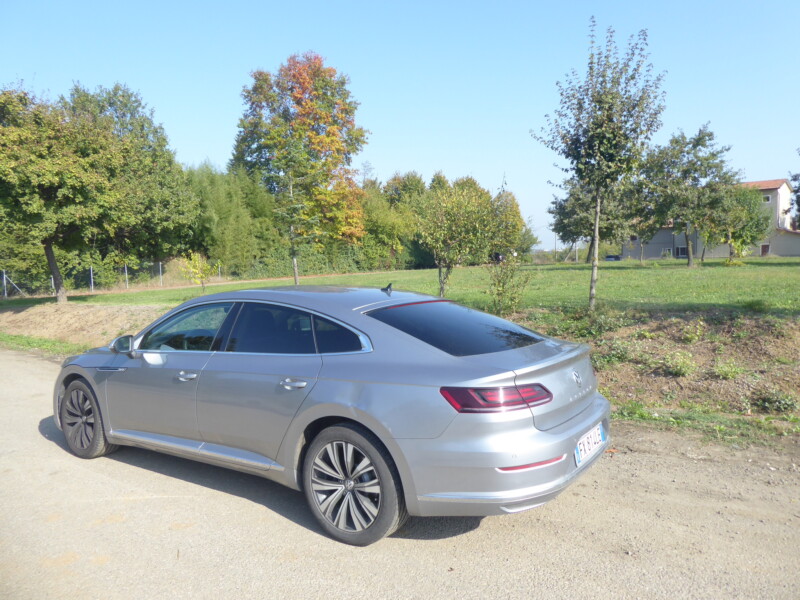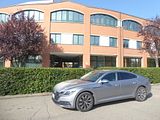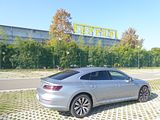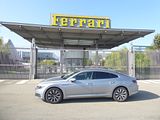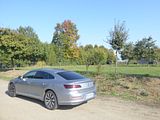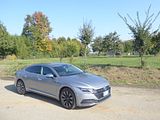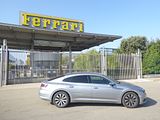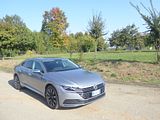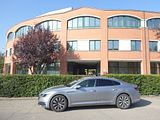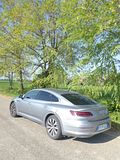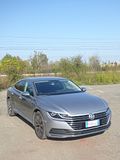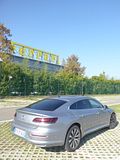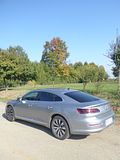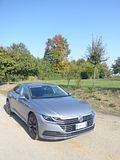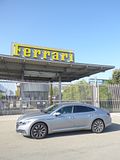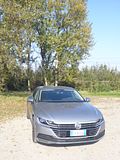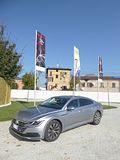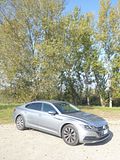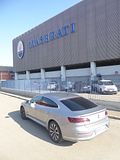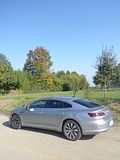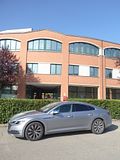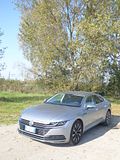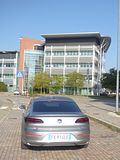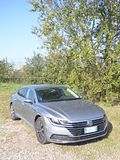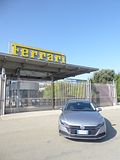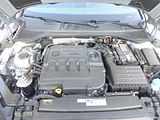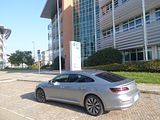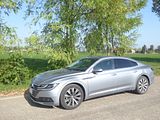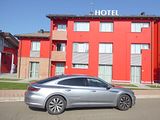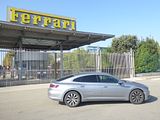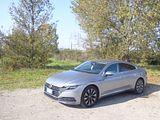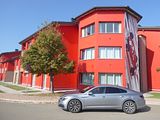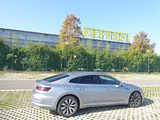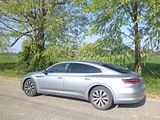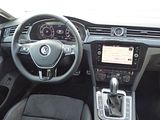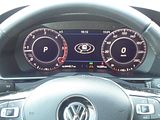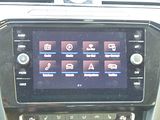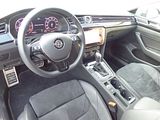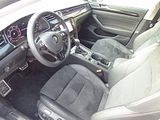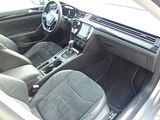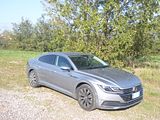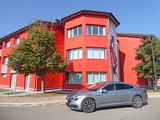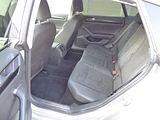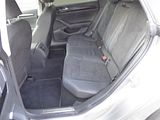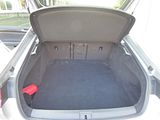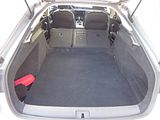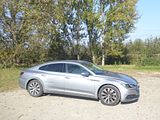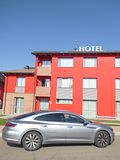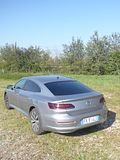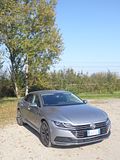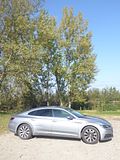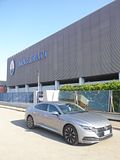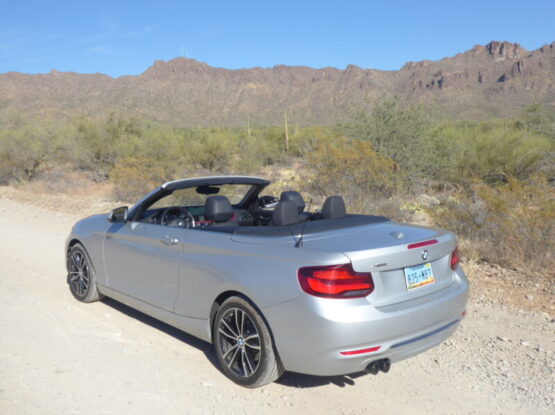Although the rental car companies try to ensure that the Car Categories and sample models that they show on their websites reflect what is on fleet, there is quite often something of a gap between cars coming and going at their locations and the updates being reflected in the booking process. This is especially the case if you want something that bit special, so there really is no substitute for having a look around the facility when you are there – something I generally do, wherever in the world I am – and sometimes asking a few questions to ascertain in what booking group certain cars are categorised. Even then, when you turn up next time, there can be surprises or disappointments, so it pays to have an open mind as to what you will actually receive in what many refer to as the “rental car lottery”. That is certainly the case for the rental here. The last few times I had been in Italy, I had seen that they did have the Alfa Romeo Giulia on fleet, though despite seeing a few examples when I asked if I could upgrade to one, I was told that sadly they were allocated to someone who booked one. So when it came to arranging this weekend in October 2019. I resolved to book one myself and duly did so. However, when I arrived in Bologna for a weekend that would take me up to the Auto Moto d’Epoca event in Padova among other destinations, I found that Hertz Italia had no Giulia models available and all they could offer me was a VW Arteon. The staff there were somewhat apologetic but as this was the best and biggest car that had on site at the time, there really was not much that they, or I could do. Disappointingly, I found that this well-used car had some fairly serious scrapes on both sides, which were going to be hard to conceal in the photos that I planned to take and which illustrate this review.
Having been previewed by a concept car in 2016, the production version of the Arteon made its debut in 2017, but more than 2 years on, it is not an especially common sight anywhere in Europe. It took over from the car which started out as the VW Passat CC and which in later life dropped the Passat part of the name in the hope that people would see it as a more upmarket proposition than the car it was based on. When it came to replacing the CC, VW decided not just on a new name, but a unique body style that was quite distinct from the Passat, even though the Arteon shares much with that car. It is based on the MQB platform, but be in no doubt, this is much larger than just about anything else that uses the same platform. The Arteon is a large car both in length and width, as I found out when I got to spend a couple of days with one. You can see the logic behind this car. VW wanted a flagship that would sit above the big-selling Passat and they had found that the ultra-luxurious Phaeton was a market step too far and they also wanted to replicate the popularity of sister group Audi’s A5 Sportback and BMW’s 4 Series Gran Coupe, with a D segment car that trades a bit of style over ultimate practicality at a premium price over the volume-selling cars. Whilst the BMW and Audi are pretty direct rivals, for cars lacking the apparently vital prestige badge, such as this VW, the Arteon does not really have any obvious direct competition, with none of the brands that do compete against the Passat, such as Ford, Opel/Vauxhall and Peugeot having gone down the same route. That led me to wonder why and also to wonder if I could figure out why the Arteon remains a rare sighting on our roads.
All Arteon models have a 2.0 litre engine, with either petrol or diesel fuel required and in Italy four wheel drive is standard on all of them, though in other markets there are cars with front wheel drive. Despite the reduction in demand for diesel models across almost all market sectors, diesel is still the fuel that powers most Arteons and that was the case for this one. It had the middle of three available power outputs, a lusty 190 bhp and was coupled to a DSG automatic gearbox. There is keyless starting with a large button in the console in front and to the left of the gearlever doing the honours. You would not mistake this for a petrol car when you start it, though it is more because it exhibits what is best called a characteristic sound as opposed to the rattly noise that used to characterise cars that took their fuel from the black pump. Once underway the noise level reduces and this is generally a quiet car with other noise sources also well suppressed. The engine is very smooth and there is strong acceleration available from almost any speed, the great slug of torque coming in particularly useful. The DSG gearbox is well suited to the car and provides seamless gearchanges. There are wheel-mounted paddles if you want to change the gears yourself, but I did not bother. Fuel economy was impressive. I drove the Arteon for 465 km during the weekend and it needed just 25.21 litres to fill it up which computes to 53.34 mpg. There is a Stop/Start system which was sometimes rather brutal when it cut back in after releasing the brake pedal.
There is leather-wrapped steering wheel which is good to hold but the rest of the driving dynamics come in the “unremarkable” category. There’s nothing that you would really complain about, but equally there is nothing to excite, either. The steering is light and there is not that much feel once underway. Handing is tidy and the standard all-wheel drive means that there is far grip than I needed. The Arteon will understeer if you push it hard, but it really is not that sort of car and there is pleasingly little in the way of body roll on those tighter corners. Better to view this a long distance comfortable cruiser revelling in the fact that the ride is well judged with just the right balance between comfort and firmness. The test car had 245/45 R18 wheels. The brakes are powerful and do a good job at stopping the car. There is an electronic handbrake in the centre console. Visibility is a mixed bag. Like most modern cars there is a high waistline and relatively thick pillars. The rear window is very steeply raked and only really gives you a good view of the sky. Perhaps this, as well as the fact that this is quite a big car is the reason why it ore quite so many dents and scratches on either side.
The interior of the Arteon very much follows current VW house style and that is no bad thing. Although there is a lot to include, the design is cohesive and the material quality is top notch with plenty of soft plastics as well as judicious use of gloss black and scored line effect inlays. The instruments are all electronic, featuring what VW call a Digital Cockpit Display. There are two large dials for the speedometer and rev counter, with fuel level and water temperature inset in the base of these. Between them there is a multi level digital display which includes trip computer functions as well as a useful digital speed repeater which I valued as I found it hard to get an exact speed reading from the main dial. Above and below this there is a lot going on, though. that’s a comment that applies to much of the rest of the Arteon, too. Whilst the column stalks are standard VW Group and the lights, with an auto function, are on a simple rotary dial on the dash to the left of the wheel, the steering wheel boss looks rather busy with no fewer than 8 buttons on each side on the wheel, those on the left being used for cruise control and those on the right for audio repeater and trip computer selections. The centre of the dash contains the integrated 8.0 inch colour touch screen for audio and infotainment functions which included a useful navigation system. This is one of the standard units that see service in a variety of VW Group products. The graphics are good and it proved easy to use. Below this are remaining switches and buttons for the audio system and then three rotary dials for the automated climate control.
Seat trim on this version of the Arteon was a rather pleasant mix of suede and leather trim. The seats themselves are branded as “Ergo Comfort”. They certainly did prove comfortable, with plenty of under-thigh support and a good shape to the cushion and backrest. Adjustment is all manual with the exception of the driver’s seat backrest for which there is an electric switch on the side of the seat and there is a lot of travel so this with far longer legs than me can get the seat far enough back. Both front seats are heated. Further helping with finding the best driving position, the steering column telescopes in and out as well as up/down and there are height adjustable seat belts.
There is a lot of space in the back, with legroom in particularly generous supply. Even with the front seats set well back, there is not going to be a problem for those with long legs. Whilst there is plenty of width, there is quite a sizeable central tunnel and the centre console comes quite well back, so a middle occupant might feel a little cramped. Headroom is more than sufficient despite the sloping rear roofline. There is a central armrest with cup holders in the upper surface and oddments can be stowed in the door bins or the pockets on the seat backs.The tailgate is massive and it is on the heavy side. I found when lowering it, a hard slam was needed to get it to close properly. Despite the very steeply sloped rear of the car, there is a commodious boot here, which is long from front to back as well as wide and quite deep under the rear parcel shelf, though there is quite a high sill over which you will have to load things. There is a space saver underneath the floor and a bit of space around it for a few odds and ends. You can get more luggage capacity either by using the ski flap or by dropping down the asymmetrically split rear seat backs. The resulting increase in space is considerable but the load floor is not flat as the dropped backrests sit higher than the boot floor. Inside the cabin, there is a large glovebox, a small cubby over the driver’s left knee, a larger one under the central armrest and some useful pockets on the doors.
In the Italian market, VW have offered the Arteon with a choice of 4 engines and 2 trim levels. There is one petrol, a 2.0 litre TSi developing 150 bhp and three diesels, all 2.0 litre units with a choice of 150 bhp, 190 bhp or in the BiTDI version 240 bhp. The trim options are Elegance and Sport. The Elegance version is intended to emphasise comfort and luxury. It comes on 18-inch alloys and the interiors have leather and Alcantara upholstery, and as standard we find a respectable endowment. All Arteons offer as standard Adaptive Cruise Control, Active Info Display digital dashboard, 8-inch infotainment system, rear view camera, full LED headlights front and rear, automatic braking and connectivity with Apple CarPlay and Android Auto. The Sport version is a little more costly. The equipment level is essentially the same with your additional money going mostly on cosmetic items. These included a reprofiled sportier front and rear bumper, door sills with R-Line logo, 19″ alloys as standard and 20″ inches as an option whilst inside there is a full leather interior, sports seats, a larger 9.2-inch Discover Pro navigation system and optionally electronically controlled suspension, Head-Up Display and XDS electronic differential. There have been other versions in other markets, including a potent 280 bhp 2.0 TSI petrol model, but this was not offered as a new car in Italy.
There was much to like about the Arteon. It is a roomy and comfortable car, that is nicely finished inside, well equipped and whilst not exciting, it is decent to drive, majoring on comfort and smoothness. It would meet the needs of most families very well, if they could convince themselves that they really don’t need the extra bulk of an SUV. But relatively few buyers seem to have agreed with this as sales have been modest at best. I think the problem is not so much the car itself but buyer expectation that a car of this size and price should have a more prestige badge than one which translates as “People’s Car”. Perhaps the reason why the Arteon has no rivals from brands that compete against other VW models is that they have all concluded that the market for cars of this size and price is just not big enough to justify creating and building them. It will be interesting to see if VW build a successor to the Arteon or not but whilst this version is production, then if you are looking for a spacious, refined and comfortable car, the Arteon fills the bill but very well, even if it is not the Alfa Giulia I was hoping to drive. Let’s hope that Hertz Italia have one of those available next time I visit.

